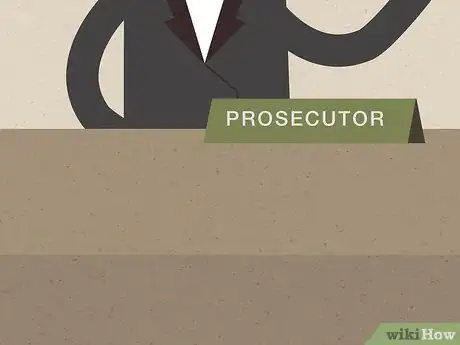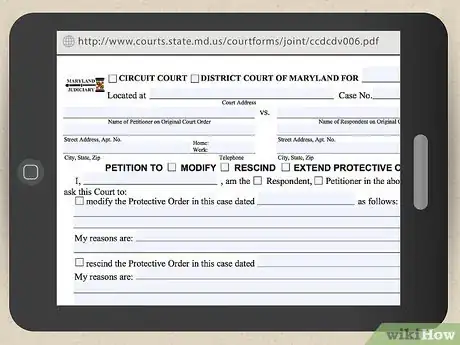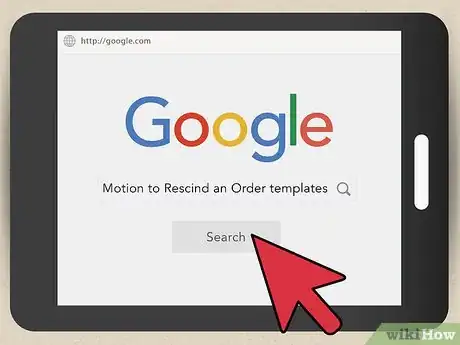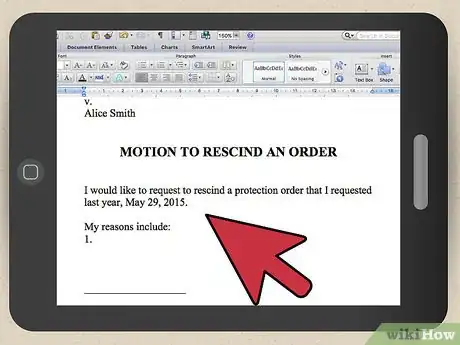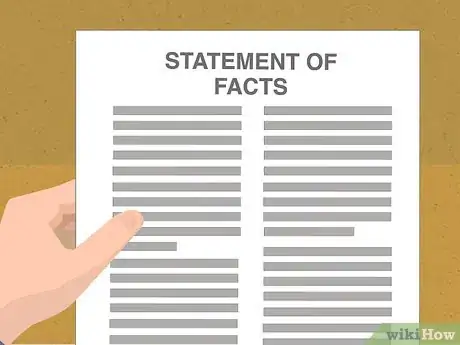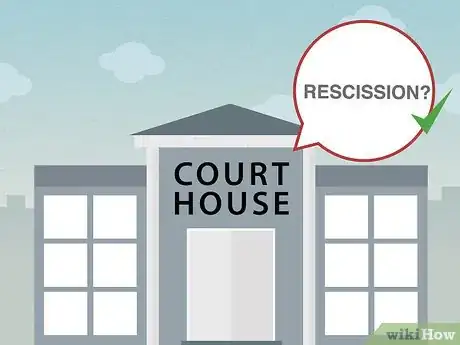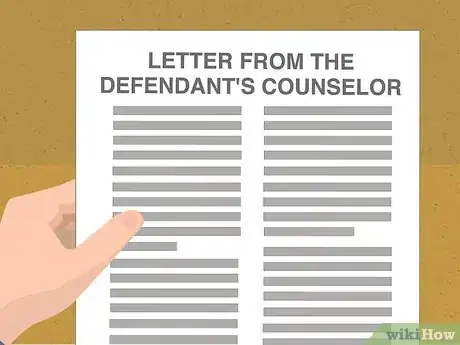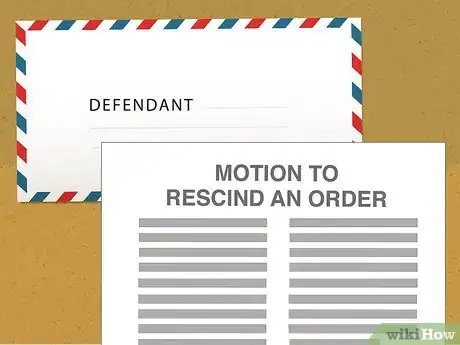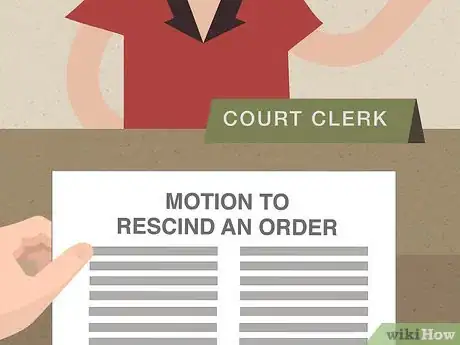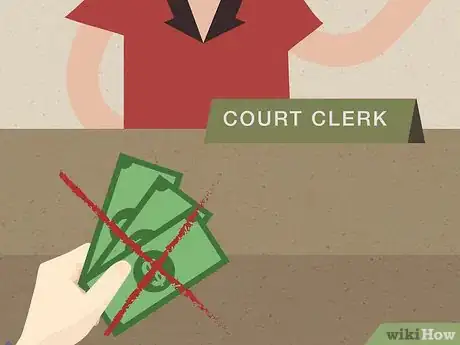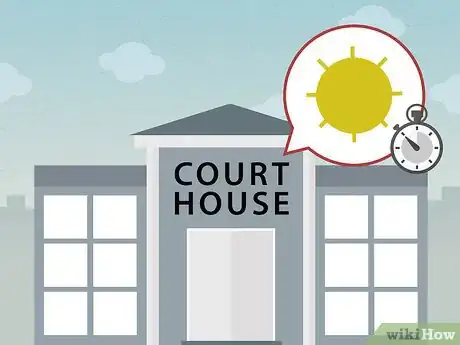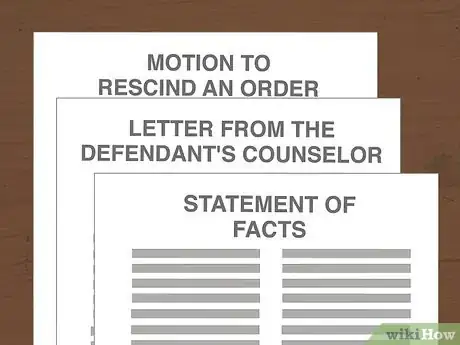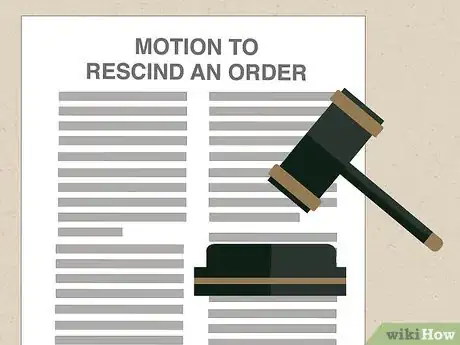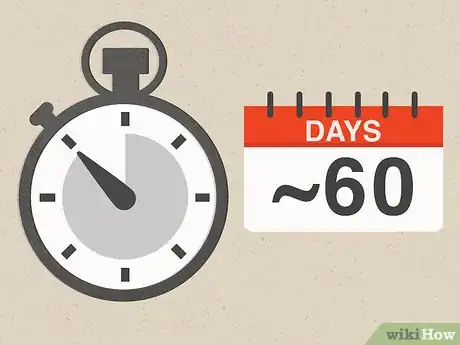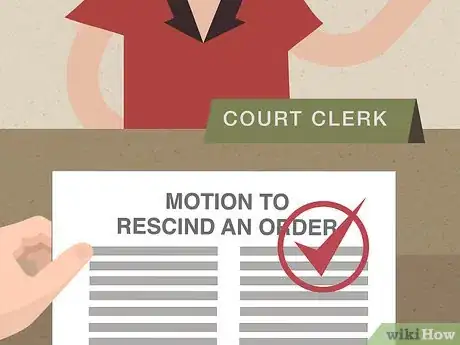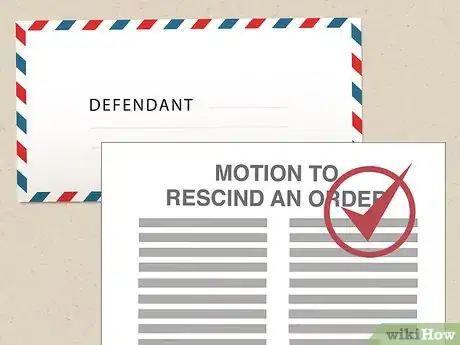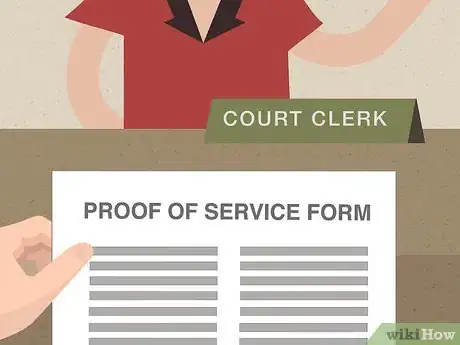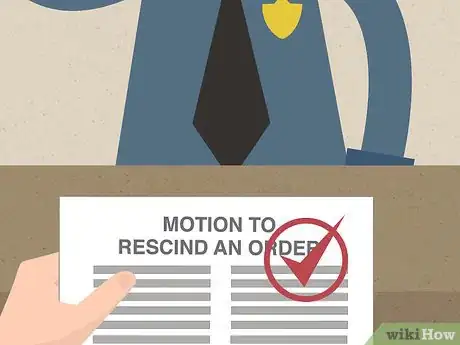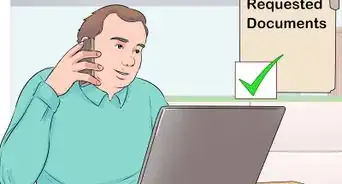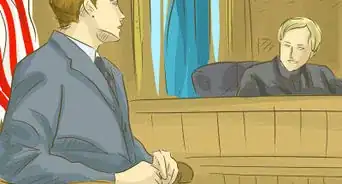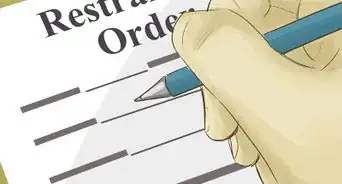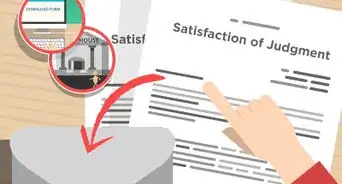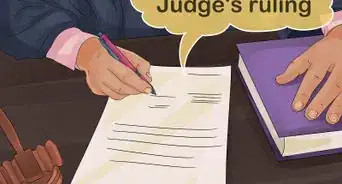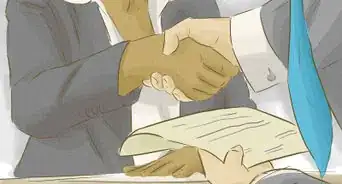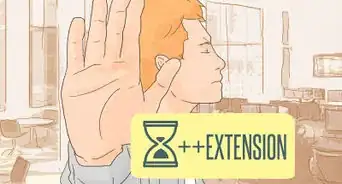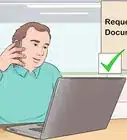This article was co-authored by Clinton M. Sandvick, JD, PhD. Clinton M. Sandvick worked as a civil litigator in California for over 7 years. He received his JD from the University of Wisconsin-Madison in 1998 and his PhD in American History from the University of Oregon in 2013.
There are 10 references cited in this article, which can be found at the bottom of the page.
This article has been viewed 47,319 times.
A protection order is granted by a judge in certain cases (e.g., domestic violence, assaults, criminal trespassing) and requires the defendant to stay away from you (the victim). If the order is ever violated, the defendant can be arrested and charged with new crimes.[1] While you are not a party in the criminal case against the defendant, you can ask the prosecutor and judge to drop (a.k.a., rescind or terminate) a protection order before the defendant's court date. This usually happens when you and the defendant have gotten back together or made amends.[2]
Steps
Drafting Your Motion to Rescind an Order
-
1Talk to the prosecutor in the case. If you feel as though it is safe to rescind a protection order and allow the defendant to have contact with you, someone will have to file a motion with the court on your behalf. In most cases, because the protection order will be part of an ongoing criminal case, the prosecutor (i.e., the lawyer representing the state) will have to help you.
- As the victim of a crime, you will most likely have already talked to the prosecutor on multiple occasions. If you have his or her phone number or email address, reach out to them and tell them what you want to do.
-
2Discuss the facts of your case. Prosecutors might be hesitant to request a rescission on your behalf if they think the action could result in additional physical or emotional harm. Once a protection order is rescinded, the defendant may have the ability to commit more crimes against you. You should only ask to have a protection order rescinded if you are sure the outcome will be positive.
- When you talk with the prosecutor, explain to him or her why and how the facts of your case have changed. The prosecutor will want to know that you will be safe moving forward. For example, if the defendant has gone to counseling, get a letter from the counselor stating the defendant is not likely to cause any more harm.
Advertisement -
3Obtain a form from your local court. If the prosecutor agrees to file a motion on your behalf, the prosecutor will either fill out a court form or draft a motion on their own. Court forms can be found online or at the courthouse. Get a copy of the form the prosecutor will be filling out so you know what information the prosecutor will need.
- For example, in Maryland, the court form will ask the moving party (i.e., the prosecutor on your behalf) to identify the ongoing case, state the purpose of the motion, state your reasoning for asking for the rescission, and identify the acts of the defendant that led to the protection order.[3]
- In Michigan, the form asks for the same type of information.
-
4Write your own motion. If your local court does not have these forms, or if the prosecutor prefers to draft his or her own, they can do so. A lot of lawyers prefer this method because it gives them the freedom and space to include all of the information they feel is important.
- Even when a lawyer chooses to draft their own motion, they will usually work from templates. A lot of states will make general motion templates available online or at the courthouse. Take time to track these templates down so you can help the prosecutor get the information they need.
-
5Include a notice of motion. The first page or two of a motion to rescind a protection order will contain the notice of motion, which tells the defendant that you are filing a motion to rescind and that a hearing date has been set.[4] This notice needs to include:[5]
- A caption, which has the court's name, the applicable case number, and the identities of the parties.
- Information about your affidavit and any exhibits, which will be attached to your notice to complete the motion.
- The date, time, and place of the hearing regarding the motion.
- A statement indicating that the defendant has been served properly.
- A place where the prosecutor can sign and date the notice.
-
6Write down what you are asking for and why. The main body of your motion will be a document called the "affidavit in support". This affidavit is a sworn statement, signed in front of a notary, telling the court why the motion to rescind a protection order should be granted. The motion, like your notice, will start with a caption.
- The first substantive section of your affidavit in support will explain what you are asking for and why. Therefore, it should start by telling the court that a protection order is in effect and that you would like it rescinded. You will then tell the court about the facts surrounding your decision.[6] [7]
- The facts surrounding your decision need to persuade the judge that a rescission will not cause you any harm or affect the pending case in any way. Therefore, include facts about how the defendant has changed and why you want contact with him or her.
-
7Incorporate a statement of facts. In addition to the facts incorporated into your reasoning section (which should be limited to facts supporting your request), you also need to include a more general statement of facts about the pending case.[8] This is necessary so the judge has everything he or she needs to make an informed decision.
- For example, if the defendant is awaiting trial on domestic abuse charges, the judge will need to know what led to those charges being filed and what has taken place since those charges were brought. The judge needs to know why the protection order was issued in the first place.
-
8Tell the court whether you have asked for a rescission before. If you have asked for a rescission before, also tell the court whether it was granted. If a rescission has been granted before but the protection order was reinstated, this is evidence that another rescission might not be a good idea. The judge will take all of this information into consideration when making a decision.
- If you asked for a rescission before and it was denied, consider the the judge's reasoning behind the denial.[9] Ask yourself whether facts have changed in such a way that the judge would look at your request differently this time.
-
9Attach important exhibits. At the end of your motion you will attach the existing protection order along with any other exhibits you feel are important. The exhibits should help explain and support your motion to rescind the protection order. For example, if you have a letter from the defendant's counselor or doctor supporting your position, attach them.
- If you discussed a document in your affidavit, that document needs to be attached.[10]
Filing Your Motion
-
1Schedule a hearing date. A hearing date will usually be set as soon as you notify the court of your intention to make a motion to rescind a protection order. In most cases, this notification will take place before you serve the defendant. This happens so you can include the hearing information in your notice of motion.
-
2Serve the defendant. The defendant needs to be made aware of your motion so he or she can respond accordingly. Courts require notice to be given by serving the defendant with a copy of your motion. Once you make copies of your motion, which will include the notice of motion, the affidavit in support, and your exhibits, someone unrelated to the case who is over the age of 18 will need to complete the service. Service must generally be completed one or two weeks before the scheduled hearing date.[11]
- You can find professional servers by contacting the prosecutor or looking online. Most professional servers will charge a small fee for their service.
- To complete service, the server will personally deliver or mail the motion to the defendant or his or her lawyer.
- It is never okay to serve the defendant yourself.[12]
-
3File the motion and any accompanying documents. Once the defendant has been served, the prosecutor will need to file the motion with the court. The court will take the originals, so make sure you have copies for your own records.[13] In addition to filing the motion, an affidavit of service must also be filed. An affidavit of service tells the court that the motion was properly served on the other party. It will be signed by the server under oath.[14]
- Most courts require these documents to be filed in person with the clerk of courts. Once the papers are filed, they will be stamped as "filed".
-
4Ask for a fee waiver. The court may require you to pay a filing fee when you file the motion. However, in a lot of states, this fee can be waived under the theory that the defendant should be responsible for the payments. In these states, the court will require the defendant to pay court costs as well as service fees.[15]
- If you have already paid court costs and filing fees, the court will require the defendant to reimburse you. Be sure you keep all receipts as evidence of the cost you incurred.
Going to Court
-
1Arrive early. Leave yourself ample time on the morning of your court date to get to the courthouse, find parking, and get through security. Security lines can be long and will usually require that you empty your pockets and remove any metal from your body. You will not be able to bring any drugs, guns, or other weapons into the courthouse. Once you get through security, find your courtroom and sit quietly until your case is called.[16]
-
2Bring copies of all paperwork. If you have documents that have not been given to the court yet, bring them with you to your hearing.[17] Even if documents have been given to the court, bring copies in case the judge asks for them.
- Being prepared for your hearing can be the difference between having your motion granted or denied. Being prepared shows the judge the motion is important to you.
-
3Discuss your motion with the judge. When your case is called, step to the front of the courtroom and join the prosecutor. In the particular case of motions to rescind protection orders, the defendant may or may not show up. The judge will ask the prosecutor questions about the motion and give him or her a chance to explain why the it should be granted.[18]
- The judge may also want to hear from you during the hearing. The judge will likely be kind but firm in his or her questioning. He or she wants to make sure that if the protection order is rescinded, you will remain safe. If you and/or the prosecutor fail to show evidence that your safety will not be jeopardized, the judge will not likely rescind the order.
Finalizing the Rescission
-
1Receive the judge's decision in court. After the judge is done questioning the lawyers and parties, he or she may make a decision right there in open court.[19] This usually happens in fairly straightforward motion hearings where the law and facts are clear.
-
2Wait for a decision outside of court. If the judge needs time to consider what he or she heard during the hearing, you may not get a decision until some time later. Each state varies in how long a judge has to issue a ruling. For example, in New York, the judge has 60 days to decide on a motion.
- Some judge will mail you the decision if you provide them with a prepaid envelope.
- Other courts may require you to check online or visit the courthouse in order to receive the final order.[20]
-
3Enter the decision with the clerk of courts. If you are successful and the judge rescinds the protection order, the rescission will not go into effect until the new order is entered with the clerk of courts. A decision is not entered until it is brought to the clerk and he or she stamps the official order.[21]
-
4Serve a notice of entry on the defendant. After the decision is entered, you need to give a copy of the order to the defendant. You do this by serving a notice of entry. Service must be completed by someone over the age of 18 who is unrelated to the case.[22]
-
5File your proof of service. When the server completes service, he or she will fill out a proof of service form and give it to you. Take this form, and a copy of the notice of entry, and file it with the court. This action tells the court that every party has been made aware of the decision.[23]
-
6Inform law enforcement of the rescission. To ensure law enforcement does not continue to enforce the protection order against the defendant, they need to be made aware of the change. Once law enforcement is made aware of the change, they will enter it into their computer system so it is no longer enforced.[24]
References
- ↑ http://www.columbuscityattorney.org/prosecution-guidetoprotection.aspx
- ↑ http://www.masslegalhelp.org/what-if-i-want-to-talk-to-the-abusive-person-or-get-back-together
- ↑ http://www.courts.state.md.us/courtforms/joint/ccdcdv006.pdf
- ↑ http://nycourts.gov/courthelp/GoingToCourt/motionsOSC.shtml
- ↑ http://nycourts.gov/courthelp/pdfs/forms/NoticeOfMotion.pdf
- ↑ http://nycourts.gov/courthelp/GoingToCourt/motionsOSC.shtml
- ↑ http://nycourts.gov/courthelp/pdfs/forms/AffidavitInSupport.pdf
- ↑ http://nycourts.gov/courthelp/GoingToCourt/motionsOSC.shtml
- ↑ http://nycourts.gov/courthelp/GoingToCourt/motionsOSC.shtml
- ↑ http://nycourts.gov/courthelp/GoingToCourt/motionsOSC.shtml
- ↑ http://nycourts.gov/courthelp/GoingToCourt/motionsOSC.shtml
- ↑ http://nycourts.gov/courthelp/GoingToCourt/service.shtml
- ↑ http://nycourts.gov/courthelp/GoingToCourt/motionsOSC.shtml
- ↑ http://nycourts.gov/courthelp/GoingToCourt/affidavitService.shtml
- ↑ http://app.leg.wa.gov/rcw/default.aspx?cite=26.50.130
- ↑ http://nycourts.gov/courthelp/GoingToCourt/motionsOSC.shtml
- ↑ http://nycourts.gov/courthelp/GoingToCourt/motionsOSC.shtml
- ↑ http://nycourts.gov/courthelp/GoingToCourt/motionsOSC.shtml
- ↑ http://nycourts.gov/courthelp/GoingToCourt/motionsOSC.shtml
- ↑ http://nycourts.gov/courthelp/GoingToCourt/motionsOSC.shtml
- ↑ http://nycourts.gov/courthelp/GoingToCourt/motionsOSC.shtml
- ↑ http://nycourts.gov/courthelp/GoingToCourt/motionsOSC.shtml
- ↑ http://nycourts.gov/courthelp/GoingToCourt/motionsOSC.shtml
- ↑ http://www.courts.ca.gov/documents/cr165.pdf
